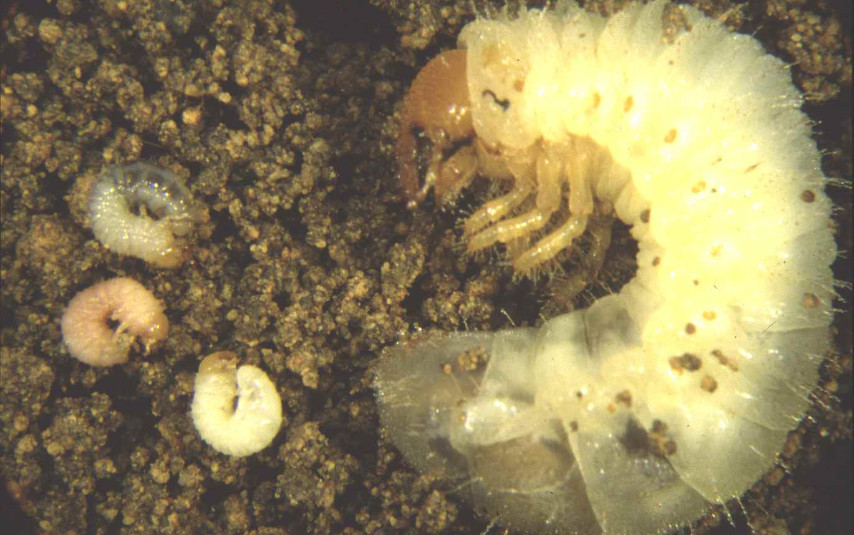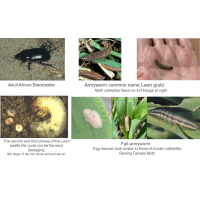- Home
- News
- In The Garden
- In The Garden - Lawn Grub

Is your grass getting circular brown areas?
Is the Grass thinning?
With either of these, it's a possibility that you may have lawn grubs.
While the grass is not dead and will grow back, it can be distressing.
There are a variety of different culprits ranging from lawn grub, lawn armyworm and lawn beetle.
African black beetle larvae; used to be the one to cause the most lawn damage.
In early 2020 the Fall armyworm was discovered in Queensland, while it is related to the armyworm, it more aggressive and does not focus purely on agricultural crops.
Fall armyworm is reported to feed on more than 350 plant species, with distinct preference for grass species.
- Egg masses look similar to those of cluster caterpillar.
- Small to medium larvae have dark spots along the body similar to medium Helicoverpa larvae.
- The pale 'Y' on the head is also found on some other armyworm species.
- FAW pupae look similar to but are smaller than Helicoverpa pupae.
The lifecycle of Armyworms (common name:lawn grub) from moth, eggs, caterpillar, takes just a couple of weeks and they feed on turf foliage at night.
The signs can sometimes be mistaken with other pests and diseases in turf and can start off with a general yellowing before the browning.
Left untreated this can rapidly lead to the death of your lawn.
Some householders encourage carnivorous birds into their garden to control the pest, however, if the grub problem is severe, bird feeding can cause extensive damage in its own right.
For best results, you will need to treat with a lawn grub destroyer.
Chemical control measures are most effective on the infant and not the adult.
As you are treating newly hatched larvae for the lawn beetle and grub, not the adult moth, treatment may have to be repeated.
In subtropical climates, such as ours, lawn grubs are more commonly seen between November to January, however, when conditions for breeding are right you will undoubtedly see them at other times as well.
As mentioned above, carnivorous birds quite enjoy lawn grub and they can be one of the first indicators there is a problem.
Another, strange as it may sound, are the stingers. A variety of them from the yellow (hairy) flower wasp to the black-winged red wasp.
They fly low around the lawn apparently fascinated by the excess of food beneath the surface - a very good indication that treatment will be required for lawn grub.
The correct names for juvenile lawn beetle are:
- white curl grub,
- scarab beetle larvae,
- lawn beetle larvae or cockchafer (white curl grub is sometimes incorrectly referred to as 'lawn grub')
Lawn Grub is a name commonly used for surface-dwelling caterpillar such as sod webworm, army worm and cutworm, which become moths.
The second and third phase of the Lawn beetle life cycle can be the most damaging ( the larger of the four larvae pictured) as they feed quite vigorously on roots and underground stems.
These African black beetle can establish in a wide variety of grasses from green & blue couch to soft leaf buffalo and Kikuyu.
Control is most effective when activity is monitored.
One way is to place a damp hessian bag or piece of carpet on the lawn at night, in the morning adult beetle can be collected and disposed of.
It is believed that garden lighting although handy to spot the adult beetle also attracts them and may have the unwanted side effect of increasing egg-laying.
Turning off as many garden lights as possible may assist in keeping numbers down.
Chemical treatment is most effective on new larvae.
Prior to treatment; water the lawn well to encourage them to come closer to the surface.
This will enhance the benefits of the treatment meaning it will not have to penetrate as far through the soil to reach the larvae.
There is a variety of products available for treatment from the larvae to the bug.
We are more than happy to work with you and help you make the best selection from our product range for effective treatment for your situation.
- Public Holidays (1)
- In The Garden (3)



